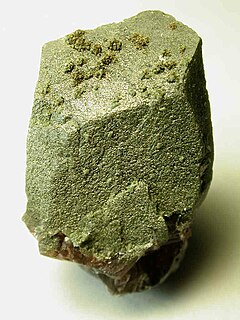Chamosite
| Chamosite | |
|---|---|

A 3.6 by 2.2 cm of Axinite-Fe covered on both sides by greenish microcrystals of Chamosite.
|
|
| General | |
| Category | Phyllosilicate |
|
Formula (repeating unit) |
(Fe2+,Mg)5Al(AlSi3O10)(OH)8 |
| Strunz classification | 9.EC.55 |
| Crystal system | Monoclinic |
| Crystal class | Prismatic (2/m) (same H-M symbol) |
| Space group | C2/m |
| Unit cell | a = 5.37 Å, b = 9.3 Å, c = 14.22 Å; β = 97.88°; Z = 2 |
| Identification | |
| Color | Green, grey-green, black |
| Mohs scale hardness | 3 |
| References | |
Chamosite is the Fe2+end member of the chlorite group. A hydrous aluminium silicate of iron, which is produced in an environment of low to moderate grade of metamorphosed iron deposits, as gray or black crystals in oolitic iron ore. Like other chlorites, it is a product of the hydrothermal alteration of pyroxenes, amphiboles and biotite in igneous rock. The composition of chlorite is often related to that of the original igneous mineral so that more fe-rich chlorites are commonly found as replacements of the fe-rich ferromagnesian minerals (Deer et al., 1992).
In 1820, Pierre Bertier; a mineralogist and mining engineer from Nemours, France, discovered chamosite. The new mineral was found in an area of low to moderate grade metamorphosed iron deposit. Early chamosite (which are chlorites) stirred some controversy after they discovered to have possessed the structure of kaolin rather than chlorite. But further research proved that chamosite was largely in existence with another phyllosilicate called berthierine (which has a kaolin type structure) which was rather difficult to distinguish from chamosites. Chamosite is named after the municipality of Chamoson, between Sion and Martigny, the canton of Valais, Switzerland.
X-ray diffraction(XRD) indicates that the proportion of 7 Å B layers in bertherine-chamosite ranges from 5 to 28%, and chemical analysis by scanning electron microscope-energy-dispersive X-ray spectroscopy (SEM-EDS) indicates positive correlation between %B and Fe/(Fe + Mg) (Ryan and Hillier, 2002). The chamosite structure is very similar to typical chlorite in which they are alternated regular layers with tetrahedral and tri-octahedral components(M.L. Rivas Sanchez et al., 2006). Its 2:1 layer structure is similar to that of mica, with a basal spacing of 14 Å. (M.L. Rivas Sanchez et al., 2006). In most common chlorites, there are 12.0 octahedral cations per O20(OH)16 and approximately equivalent amounts of aluminium in tetrahedral and octahedral sites [e.g. the magnesia chlorite, clinochlore, (Mg10Al2)(Si6Al2O20)(OH)16] (Deer et al., 1992).
...
Wikipedia
